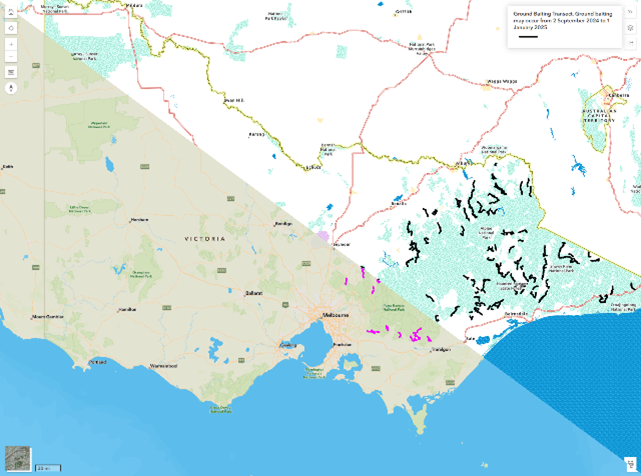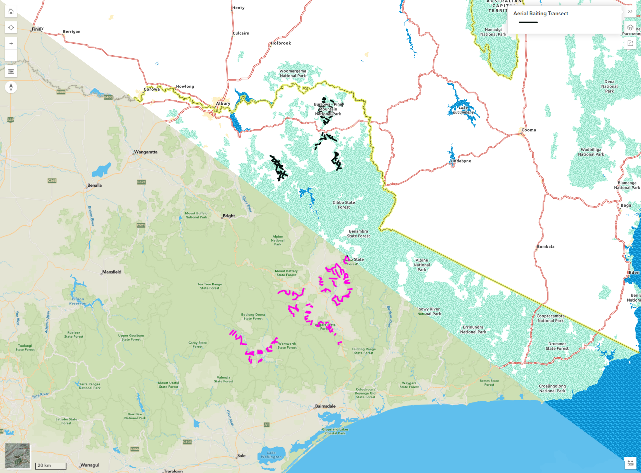Baiting notifications
Baiting is an effective control technique that involves strategic placement of baits in areas where dingoes and wild dogs are known to kill livestock. The Vertebrate Species Management Program (previously known as the Wild Dog Program) uses 1080 baits registered for use in Victoria which may be either shelf stable manufactured baits or fresh meat baits.
Ground baiting
Current ground baiting period
Ground baiting will be occurring from 1 January to 1 July 2025.
Ground baiting locations
Interactive ground baiting notification maps

The interactive ground baiting notification maps display where ground baiting may be undertaken between the stated baiting period.
View the maps
Ground baiting notification
The Department of Energy, Environment and Climate Action (DEECA) will be undertaking a 1080 poisoning program using buried baits and canid pest ejectors on public land to manage livestock predation by dingoes and wild dogs.
Awareness of 1080 bait use on public land by DEECA is vital for the safe management of domestic animals. If a property is occupied or used by persons other than yourself, the provision of this information by you to them may reduce the potentially negative impacts of 1080 on domestic animals such as pets and working dogs.
The poison to be used is compound 1080 (sodium fluoroacetate), which is contained in an approved bait type.
Poisoning will occur from 1 January to 1 July 2025, after which DEECA will collect and dispose of untaken and unused baits in accordance with the directions for use of 1080 and PAPP bait products (the directions). The use of the 1080 bait product will comply with the product label and the directions. When used in accordance with the product label and the directions, the chances of non-target animal impacts are reduced, but there is still some associated risk. By being aware of the dangers, you can help manage the risk.
Minimise risk
To minimise the risk of poisoning to your animals you are advised to:
- confine, muzzle and/or restrain your domestic animals, particularly dogs and cats, to prevent them from accessing 1080 poison baits or carcasses. These animals are susceptible to primary poisoning from ingesting 1080 bait products and secondary poisoning from ingesting contaminated carcasses. It is unusual for domestic animals to scavenge on dog/fox carcasses
- closely monitor the health and behaviour of your companion animals or livestock. If you notice any unusual or uncharacteristic behaviour contact your local veterinarian immediately
- be aware that there is a delay in the poison action of 1080 and animals that have ingested 1080 bait products may die on your property
- collect and destroy any poisoned carcasses you find by burning (in accordance with local regulations) or burying to a depth of at least 50 cm for rabbits and at least one metre for foxes, large canids and feral pigs
- always dispose of carcasses away from natural features such as waterways.
Dangers to humans
Compound 1080 is a restricted schedule 7 poison and there is no known antidote. If you are handling poison bait and/or carcasses always use protective rubber gloves and wash hands and gloves thoroughly after contact.
When used in accordance with the product label and the directions, there is minor risk of humans being poisoned by 1080 bait products. Although the 1080 used in 1080 bait products is substantially diluted, 1080 baits and poisoned carcasses must be treated with care.
If poisoning occurs immediately contact a doctor or the Poisons Information Centre on 13 11 26.
Ground baiting notification documents
- Notification of 1080 baiting program (PDF - 3.9 MB)
- Notification of 1080 baiting program – accessible (WORD - 4.8 MB)
Aerial baiting
Current aerial baiting period
Aerial baiting occurred from 14 October 2024 to 25 November 2024.
Aerial baiting locations
Interactive aerial baiting map
 The interactive aerial baiting notification maps display where aerial baiting may be undertaken between the stated baiting period.
The interactive aerial baiting notification maps display where aerial baiting may be undertaken between the stated baiting period.
View the maps
Notification
The Department of Energy, Environment, and Climate Action (DEECA) will be undertaking a 1080 baiting program using aerially deployed fresh meat baits on public land to manage livestock predation by dingoes and wild dogs.
Awareness of 1080 bait use on public land by DEECA is vital for the safe management of domestic animals. If a property is occupied or used by persons other than yourself, the provision of this information, by you to them may reduce the potentially negative impacts of 1080 on domestic animals such as pets and working dogs.
The poison to be used is compound 1080 (sodium fluoroacetate) which is contained within an approved bait type.
Poisoning will occur from 14 October 2024 to 25 November 2024 after which time DEECA will not collect unused baits in accordance with the program being conducted under an off-label section 25A permit to allow baits to be deployed from the air. The use of the 1080 bait product will comply with the product label and the directions. When used in accordance with the product label and the directions the chances of non-target animal impacts are reduced but there is still some associated risk. By being aware of the dangers you can help manage the risk.
Minimise risk
To minimise the risk of poisoning to your animals you are advised to:
- confine, muzzle and/or restrain your domestic animals, particularly dogs and cats, to prevent them from accessing 1080 poison baits or carcasses. These animals are susceptible to primary poisoning from ingesting 1080 bait products and secondary poisoning from ingesting contaminated carcasses. It is unusual for domestic animals to scavenge on dog/fox carcasses
- closely monitor the health and behaviour of your companion animals or livestock. If you notice any unusual or uncharacteristic behaviour contact your local veterinarian immediately
- be aware that there is a delay in the poison action of 1080 and animals that have ingested 1080 bait products may die on your property
- collect and destroy any poisoned carcasses you find by burning (in accordance with local regulations) or burying to a depth of at least 50 cm for rabbits and at least one metre for foxes, large canids and feral pigs
- always dispose of carcasses away from natural features such as waterways.
Dangers to humans
Compound 1080 is a restricted schedule 7 poison and there is no known antidote. If you are handling poison bait and/or carcasses always use protective rubber gloves and wash hands and gloves thoroughly after contact.
When used in accordance with the product label and the directions, there is minor risk of humans being poisoned by 1080 bait products. Although the 1080 used in 1080 bait products is substantially diluted, 1080 baits and poisoned carcasses must be treated with care.
If poisoning occurs, immediately contact a doctor or the Poisons Information Centre on 13 11 26.
Aerial baiting notifications
Notification of 1080 aerial baiting program (PDF - 3.5 MB)
Notification of 1080 aerial baiting program – accessible (WORD - 4.1 MB)
Further Information
For detailed information on baiting contact:
Gippsland Region
Wayne Peters
Vertebrate Species Management Program
Gippsland Operations Manager
Telephone: 0429 401 217
Email: wayne.w.peters@deeca.vic.gov.au
Hume Region
Craig Hamilton
Vertebrate Species Management Program
Hume Operations Manager
Telephone: 0429 969 413
Email: craig.hamilton@deeca.vic.gov.au
Alternatively email vertebratespeciesmanagement@deeca.vic.gov.au
For further information about baiting and wild dog management visit livestock predation management.
You can also find more information on using and handling of 1080 from 1080 bait manufacturers.